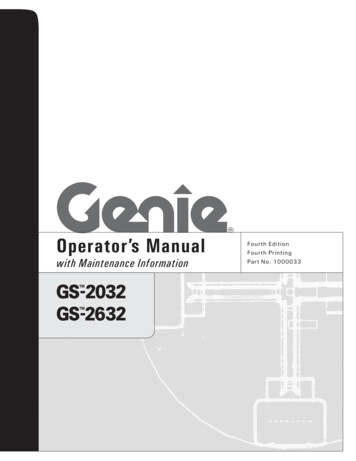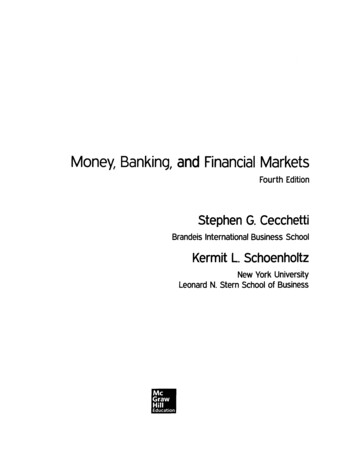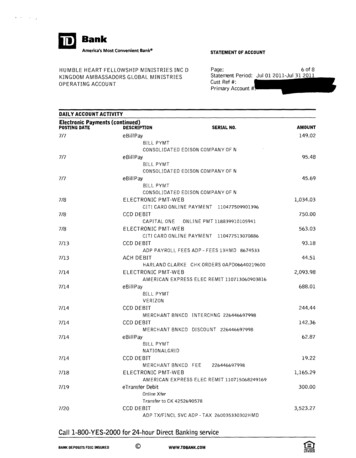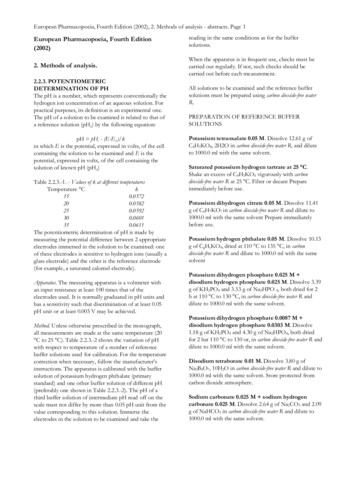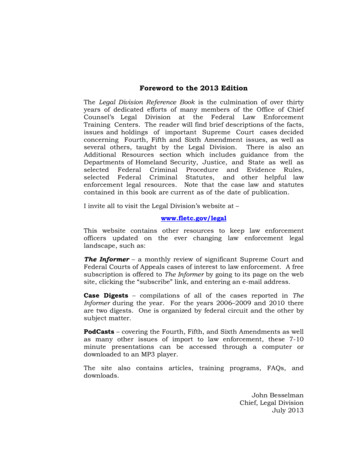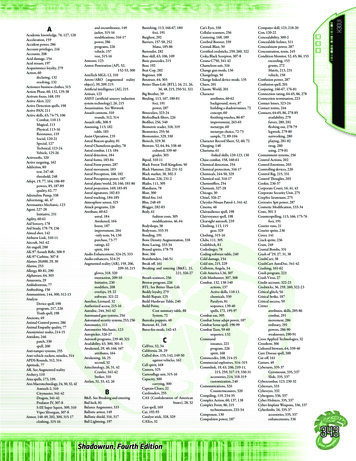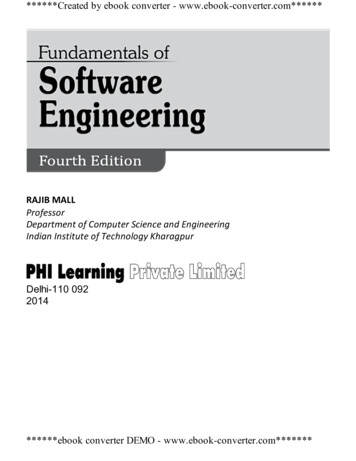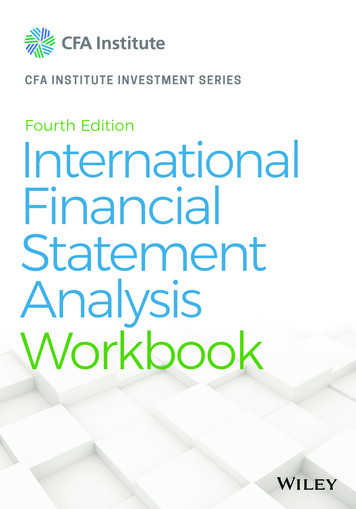
Transcription
Fourth book
INTERNATIONALFINANCIALSTATEMENTANALYSISWORKBOOK
CFA Institute is the premier association for investment professionals around the world, withmore than 150,000 CFA charterholders worldwide in 165 countries and regions. Since 1963the organization has developed and administered the renowned Chartered Financial Analyst Program. With a rich history of leading the investment profession, CFA Institute has set thehighest standards in ethics, education, and professional excellence within the global investmentcommunity and is the foremost authority on investment profession conduct and practice.Each book in the CFA Institute Investment Series is geared toward industry practitioners alongwith graduate-level finance students and covers the most important topics in the industry. Theauthors of these cutting-edge books are themselves industry professionals and academics andbring their wealth of knowledge and expertise to this series.
rth EditionThomas R. Robinson, CFAElaine Henry, CFAMichael A. Broihahn, CFA
Cover image: akinbostanci/Getty ImagesCover design: WileyCopyright 2020 by CFA Institute. All rights reserved.Published by John Wiley & Sons, Inc., Hoboken, New Jersey.The First and Second Editions of this book were published by Wiley in 2008 and 2012 respectively.Published simultaneously in Canada.No part of this publication may be reproduced, stored in a retrieval system, or transmitted in any form or byany means, electronic, mechanical, photocopying, recording, scanning, or otherwise, except as permitted underSection 107 or 108 of the 1976 United States Copyright Act, without either the prior written permission of thePublisher, or authorization through payment of the appropriate per-copy fee to the Copyright Clearance Center,Inc., 222 Rosewood Drive, Danvers, MA 01923, (978) 750-8400, fax (978) 646-8600, or on the Web atwww.copyright.com. Requests to the Publisher for permission should be addressed to the Permissions Department,John Wiley & Sons, Inc., 111 River Street, Hoboken, NJ 07030, (201) 748-6011, fax (201) 748-6008, or onlineat www.wiley.com/go/permissions.Limit of Liability/Disclaimer of Warranty: While the publisher and author have used their best efforts in preparingthis book, they make no representations or warranties with respect to the accuracy or completeness of the contentsof this book and specifically disclaim any implied warranties of merchantability or fitness for a particular purpose.No warranty may be created or extended by sales representatives or written sales materials. The advice and strategiescontained herein may not be suitable for your situation. You should consult with a professional where appropriate.Neither the publisher nor author shall be liable for any loss of profit or any other commercial damages, includingbut not limited to special, incidental, consequential, or other damages.For general information on our other products and services or for technical support, please contact our CustomerCare Department within the United States at (800) 762-2974, outside the United States at (317) 572-3993 orfax (317) 572-4002.Wiley publishes in a variety of print and electronic formats and by print-on-demand. Some material included withstandard print versions of this book may not be included in e-books or in print-on-demand. If this book refers tomedia such as a CD or DVD that is not included in the version you purchased, you may download this material athttp://booksupport.wiley.com. For more information about Wiley products, visit www.wiley.com.ISBN 978-1-119-62809-5 (paper)ISBN 978-1-119-70523-9 (ePDF)ISBN 978-1-119-62812-5 (ePub)Printed in the United States of America.10 9 8 7 6 5 4 3 2 1
CONTENTSPART ILearning Objectives, Summary Overview, and Problems1CHAPTER 1Introduction to Financial Statement Analysis3Learning OutcomesSummary OverviewProblems335CHAPTER 2Financial Reporting StandardsLearning OutcomesSummary OverviewProblems99910CHAPTER 3Understanding Income Statements13Learning OutcomesSummary OverviewProblems131415CHAPTER 4Understanding Balance Sheets21Learning OutcomesSummary OverviewProblems212123CHAPTER 5Understanding Cash Flow Statements29Learning OutcomesSummary OverviewProblems292930CHAPTER 6Financial Analysis Techniques37Learning OutcomesSummary OverviewProblems373738v
viContentsCHAPTER 7Inventories45Learning OutcomesSummary OverviewProblems454547CHAPTER 8Long-Lived Assets63Learning OutcomesSummary OverviewProblems636465CHAPTER 9Income Taxes77Learning OutcomesSummary OverviewProblems777778CHAPTER 10Non-Current (Long-Term) Liabilities83Learning OutcomesSummary OverviewProblems838385CHAPTER 11Financial Reporting Quality91Learning OutcomesSummary OverviewProblems919193CHAPTER 12Applications of Financial Statement Analysis97Learning OutcomesSummary OverviewProblems979798CHAPTER 13Intercorporate InvestmentsLearning OutcomesSummary OverviewProblems101101101102CHAPTER 14Employee Compensation: Post-Employment and Share-BasedLearning OutcomesSummary OverviewProblems113113113115
ContentsviiCHAPTER 15Multinational OperationsLearning OutcomesSummary OverviewProblems125125125127CHAPTER 16Analysis of Financial InstitutionsLearning OutcomesSummary OverviewProblems139139139140CHAPTER 17Evaluating Quality of Financial ReportsLearning OutcomesSummary OverviewProblems149149149151CHAPTER 18Integration of Financial Statement Analysis TechniquesLearning OutcomesSummary OverviewProblems157157157158PART IISolutions161CHAPTER 1Introduction to Financial Statement AnalysisSolutions163163CHAPTER 2Financial Reporting StandardsSolutions165165CHAPTER 3Understanding Income StatementsSolutions167167CHAPTER 4Understanding Balance SheetsSolutions171171CHAPTER 5Understanding Cash Flow StatementsSolutions175175CHAPTER 6Financial Analysis TechniquesSolutions179179
viiiContentsCHAPTER 7InventoriesSolutions183183CHAPTER 8Long-Lived AssetsSolutions191191CHAPTER 9Income TaxesSolutions197197CHAPTER 10Non-Current (Long-Term) LiabilitiesSolutions199199CHAPTER 11Financial Reporting QualitySolutions207207CHAPTER 12Applications of Financial Statement AnalysisSolutions211211CHAPTER 13Intercorporate InvestmentsSolutions213213CHAPTER 14Employee Compensation: Post-Employment and Share-BasedSolutions219219CHAPTER 15Multinational OperationsSolutions225225CHAPTER 16Analysis of Financial InstitutionsSolutions233233CHAPTER 17Evaluating Quality of Financial ReportsSolutions241241CHAPTER 18Integration of Financial Statement Analysis TechniquesSolutionsAbout the CFA Program245245247
PARTLEARNING OBJECTIVES,SUMMARY OVERVIEW,AND PROBLEMSI
CHAPTER1INTRODUCTION TOFINANCIAL STATEMENTANALYSISLEARNING OUTCOMESAfter completing this chapter, you will be able to do the following: describe the roles of financial reporting and financial statement analysis; describe the roles of the statement of financial position, statement of comprehensive income,statement of changes in equity, and statement of cash flows in evaluating a company’s performance and financial position; describe the importance of financial statement notes and supplementary information—including disclosures of accounting policies, methods, and estimates—and management’scommentary; describe the objective of audits of financial statements, the types of audit reports, and theimportance of effective internal controls; identify and describe information sources that analysts use in financial statement analysisbesides annual financial statements and supplementary information; describe the steps in the financial statement analysis framework.SUMMARY OVERVIEWThe information presented in financial and other reports, including the financial statements,notes, and management’s commentary, helps the financial analyst to assess a company’s performance and financial position. An analyst may be called on to perform a financial analysisfor a variety of reasons, including the valuation of equity securities, the assessment of creditrisk, the performance of due diligence on an acquisition, and the evaluation of a subsidiary’sperformance relative to other business units. Major considerations in both equity analysis and3
4Part I: Learning Objectives, Summary Overview, and Problemscredit analysis are evaluating a company’s financial position, its ability to generate profits andcash flow, and its potential to generate future growth in profits and cash flow.This chapter has presented an overview of financial statement analysis. Among the majorpoints covered are the following: The primary purpose of financial reports is to provide information and data about a company’s financial position and performance, including profitability and cash flows. Theinformation presented in the reports —including the financial statements and notes andmanagement’s commentary or management’s discussion and analysis—allows the financial analyst to assess a company’s financial position and performance and trends in thatperformance. The primary financial statements are the statement of financial position (i.e., the balancesheet), the statement of comprehensive income (or two statements consisting of an incomestatement and a statement of comprehensive income), the statement of changes in equity,and the statement of cash flows. The balance sheet discloses what resources a company controls (assets) and what it owes(liabilities) at a specific point in time. Owners’ equity represents the net assets of the company; it is the owners’ residual interest in, or residual claim on, the company’s assets afterdeducting its liabilities. The relationship among the three parts of the balance sheet (assets,liabilities, and owners’ equity) may be shown in equation form as follows: Assets Liabilities Owners’ equity. The income statement presents information on the financial results of a company’s businessactivities over a period of time. The income statement communicates how much revenueand other income the company generated during a period and what expenses, includinglosses, it incurred in connection with generating that revenue and other income. The basicequation underlying the income statement is Revenue Other income – Expenses Netincome. The statement of comprehensive income includes all items that change owners’ equity excepttransactions with owners. Some of these items are included as part of net income, and someare reported as other comprehensive income (OCI). The statement of changes in equity provides information about increases or decreases in thevarious components of owners’ equity. Although the income statement and balance sheet provide measures of a company’s success,cash and cash flow are also vital to a company’s long-term success. Disclosing the sourcesand uses of cash helps creditors, investors, and other statement users evaluate the company’sliquidity, solvency, and financial flexibility. The notes (also referred to as footnotes) that accompany the financial statements are anintegral part of those statements and provide information that is essential to understandingthe statements. Analysts should evaluate note disclosures regarding the use of alternativeaccounting methods, estimates, and assumptions. In addition to the financial statements, a company provides other sources of informationthat are useful to the financial analyst. As part of his or her analysis, the financial analystshould read and assess this additional information, particularly that presented in the management commentary (also called management report[ing], operating and financial review,and management’s discussion and analysis [MD&A]). A publicly traded company must have an independent audit performed on its annual financial statements. The auditor’s report expresses an opinion on the financial statements and
Chapter 1Introduction to Financial Statement Analysis5provides some assurance about whether the financial statements fairly present a company’sfinancial position, performance, and cash flows. In addition, for US publicly traded companies, auditors must also express an opinion on the company’s internal control systems. Information on the economy, industry, and peer companies is useful in putting the company’s financial performance and position in perspective and in assessing the company’s future.In most cases, information from sources apart from the company are crucial to an analyst’seffectiveness. The financial statement analysis framework provides steps that can be followed in any financial statement analysis project. These steps are: articulate the purpose and context of the analysis; collect input data; process data; analyze/interpret the processed data; develop and communicate conclusions and recommendations; and follow up.PROBLEMS1. Providing information about the performance and financial position of companies so thatusers can make economic decisions bestt describes the role of:A. auditing.B. financial reporting.C. financial statement analysis.2. Which of the following best describes the role of financial statement analysis?A. To provide information about a company’s performance.B. To provide information about a company’s changes in financial position.C. To form expectations about a company’s future performance and financial position.3. The role of financial statement analysis is bestt described as:A. providing information useful for making investment decisions.B. evaluating a company for the purpose of making economic decisions.C. using financial reports prepared by analysts to make economic decisions.4. A company’s financial position would bestt be evaluated using the:A. balance sheet.B. income statement.C. statement of cash flows.5. A company’s profitability for a period would bestt be evaluated using the:A. balance sheet.B. income statement.C. statement of cash flows.6. The financial statement that presents a shareholder’s residual claim on assets is the:A. balance sheet.B. income st
Each book in the CFA Institute Investment Series is geare d towar d industry practitioners a long with graduate-level fi nance students and covers t he most important topics in t he industry. Th e authors of these cutting-edge books are themselves industry professionals and academics and bring their wealth of knowledge and expertise to this series. INTERNATIONAL FINANCIAL STATEMENT ANALYSIS .
